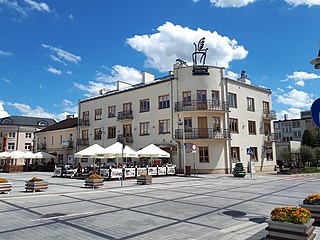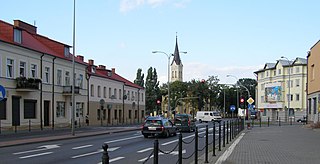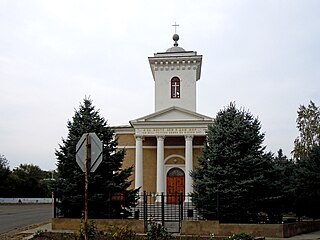Wendisch-Rambow is a village of Schwerin in northern Germany. It is in the state of Mecklenburg-Western Pomerania. The population as of 1996 was approximately 201.
Wendisch-Rambow is a village of Schwerin in northern Germany. It is in the state of Mecklenburg-Western Pomerania. The population as of 1996 was approximately 201.
Rambow is mentioned in 1282 in a document, in which Duke Mestwin II of the Stanislaus church, in guard of its father, confirmed donations. In 1531, it was held by Chorken. Rambow came into the possession of the Grumbkows in 1724. The Minister of State Philipp Otto von Grumbkow sold it 1733 at Joachim honour realm of Kettelhack, and of this they turned into the family from Kleist.
At the end of World War II, the Russians occupied this area and drove out the residents. The inhabitants of nearby Ramnitz could not escape the Russian advance. They hid in the Rambower forest and returned on the following day to the village. The East Prussia refugees had fled the Russians, but more people came after that. The Russians occupied Ramnitz in the evening hours of 8 March 1945.
Poland could, because of the Russian crew, only 1950 into the possession of the village set itself. The inhabitants were driven out at a relatively late time from their homeland. The residence card index Pommern determined 192 refugees from this village in the Federal Republic of Germany and 78 in the GDR. The German municipality, Ramnitz, became the Polish Karznica.
There were approximately 201 inhabitants in the village as of 1996.

Population transfer or resettlement is a type of mass migration, often imposed by state policy or international authority and most frequently on the basis of ethnicity or religion but also due to economic development. Banishment or exile is a similar process, but is forcibly applied to individuals and groups. Population transfer differs more than simply technically from individually motivated migration, but at times of war, the act of fleeing from danger or famine often blurs the differences. If a state can preserve the fiction that migrations are the result of innumerable "personal" decisions, the state may be able to claim that it is not to blame for the displacement.
This article lists expulsions, refugee crises and other forms of displacement that have affected Jews.

Piaseczno is a town in east-central Poland with 47,660 inhabitants. It is situated in the Masovian Voivodeship, within the Warsaw metropolitan area, just south of Warsaw, approximately 16 kilometres south of its center. It is a residential area and a suburb of Warsaw. It is the capital city of Piaseczno County.

Radzyń Podlaskipronounced[ˈrad͡zɨɲpɔdˈlaskʲi] is a town in eastern Poland, about 60 km north of Lublin, with 15,808 inhabitants (2017). Situated in the Lublin Voivodeship since 1999, previously it was part of the Biała Podlaska Voivodeship (1975–1998). It is the capital of Radzyń Podlaski County, and historically belongs to the region of Lesser Poland. The town was founded in 1468, and its most important landmark is the rococo Potocki Palace.

Grajewo is a town in north-eastern Poland with 21,499 inhabitants (2016). It is the capital of Grajewo County within the Podlaskie Voivodeship. It is located within the historic region of Masovia, near the border with Podlachia and Masuria.

Stowięcino is a village in the administrative district of Gmina Główczyce, within Słupsk County, Pomeranian Voivodeship, in northern Poland. It lies approximately 10 kilometres (6 mi) south-east of Główczyce, 32 km (20 mi) east of Słupsk, and 78 km (48 mi) west of the regional capital Gdańsk.

Sarata is an urban-type settlement in Bilhorod-Dnistrovskyi Raion, Odesa Oblast (region) of south-western Ukraine. It is a part of the Bessarabian historic district of Budjak. Sarata hosts the administration of Sarata settlement hromada, one of the hromadas of Ukraine. Population: 4,159.

Schönkirchen is a municipality in the district of Plön, in Schleswig-Holstein, Germany.

Dojlidy Brewery is a brewery located in Białystok, Poland, and owned by Kompania Piwowarska SA, the Polish subsidiary of Asahi Breweries. The brewery was modernized between 1997 and 1999, then in 2003 it was purchased by Kompania Piwowarska SA. The Dojlidy Brewery used to make many different brands of beer, after being bought by Kompania Piwowarska S.A. their main product is Żubr. Żubr is one of the most popular beers in Poland and is also on sale throughout Europe.
The Russian Protective Corps was an armed force composed of anti-communist White Russian émigrés that was raised in the German occupied territory of Serbia during World War II. Commanded for almost its whole existence by Lieutenant General Boris Shteifon, it served primarily as a guard force for factories and mines between late 1941 and early 1944, initially as the "Separate Russian Corps" then Russian Factory Protective Group. It was incorporated into the Wehrmacht on 1 December 1942 and later clashed with the communist-led Yugoslav Partisans and briefly with the Chetniks. In late 1944, it fought against the Red Army during the Belgrade Offensive, later withdrawing to Bosnia and Slovenia as the German forces retreated from Yugoslavia and Greece. After Shteifon′s death in Zagreb, the Independent State of Croatia, on 30 April 1945, Russian Colonel Anatoly Rogozhin took over and led his troops farther north to surrender to the British in southern Austria. Unlike most other Russian formations that fought for Nazi Germany, Rogozhin and his men, who were not formally treated as Soviet citizens, were exempt from forced repatriation to the Soviet Union and were eventually set free and allowed to resettle in the West.
Lyakhavichy is a town in Brest Region, Belarus. It serves as the administrative center of Lyakhavichy District. As of 2023, it has a population of 10,613.

The Circassian genocide, or Tsitsekun, was the Russian Empire's systematic mass murder, ethnic cleansing, and expulsion of 95–97% of the Circassian population, resulting in 1 to 1.5 million deaths during the final stages of the Russo-Circassian War. The peoples planned for extermination were mainly the Muslim Circassians, but other Muslim peoples of the Caucasus were also affected. Killing methods used by Russian forces during the genocide included impaling and tearing the bellies of pregnant women as means of intimidation of the Circassian population. Russian generals such as Grigory Zass described the Circassians as "subhuman filth", and glorified the mass murder of Circassian civilians, justified their use in scientific experiments, and allowed their soldiers to rape women.

Kljajićevo is a village in Serbia. It is situated in the Sombor municipality, in the West Bačka District, Vojvodina province. The village has a Serb ethnic majority and its population numbered 6,012 people.

The Kamianets-Podilskyi massacre was a World War II mass shooting of Jews carried out in the opening stages of Operation Barbarossa, by the German Police Battalion 320 along with Friedrich Jeckeln's Einsatzgruppen, Hungarian soldiers, and the Ukrainian Auxiliary Police. The killings were conducted on August 27 and August 28, 1941, in the Soviet city of Kamianets-Podilskyi, occupied by German troops in the previous month on July 11, 1941. According to the Nazi German reports a total of 23,600 Jews were murdered, including 16,000 who had earlier been expelled from Hungary.

Ohrana were armed collaborationist detachments organized by the former Internal Macedonian Revolutionary Organization (IMRO) structures, composed of Bulgarians in Nazi-occupied Greek Macedonia during World War II and led by officers of the Bulgarian Army. Bulgaria was interested in acquiring Thessalonica and Western Macedonia, under Italian and German occupation and hoped to sway the allegiance of the 80,000 Slavs who lived there at the time. The appearance of Greek partisans in those areas persuaded the Axis to allow the formation of these collaborationst detachments. However, during late 1944, when the Axis appeared to be losing the war, many Bulgarian Nazi collaborators, Ohrana members and VMRO regiment volunteers fled to the opposite camp by joining the newly founded communist SNOF. The organization managed to recruit initially 1,000 up to 3,000 armed men from the Slavophone community that lived in the western part of Greek Macedonia.

The Minsk Ghetto was created soon after the German invasion of the Soviet Union. It was one of the largest in the Byelorussian SSR, and the largest in the German-occupied territory of the Soviet Union. It housed close to 100,000 Jews, most of whom were murdered in The Holocaust.
Demydivka is an urban-type settlement in Rivne Oblast, Ukraine. It was the administrative center of Demydivka Raion within the oblast until the raion was abolished in 2020. The settlement is located 40 kilometres (25 mi) from the railway station on the Dubno-Krasne-Zdolbuniv line. Population: 2,440.

Klein Warnow station is a former station on the Berlin–Hamburg railway in the town of Klein Warnow in the German state of Brandenburg. The station was most important during its first 20 years of operation after its opening in 1846/47, when it was the Prussian border station at the border with Mecklenburg. Since the abandonment of passenger services in 1993, the station has only served corporate purposes. The station building and a number of other buildings have heritage protection.

Emigration of Jews from Nazi Germany and German-occupied Europe started after Adolf Hitler came into power in 1933. Jews also began to escape German-occupied Europe.

The razing of Vorizia refers to the destruction of the village of Vorizia (Βορίζια) in Crete (Greece) by aerial bombardment and the murder of five of its inhabitants on 27 August 1943 by German occupying forces during World War II.